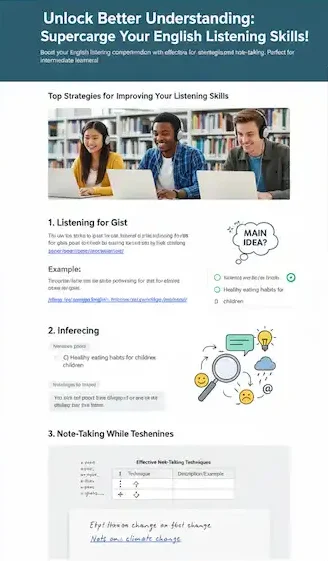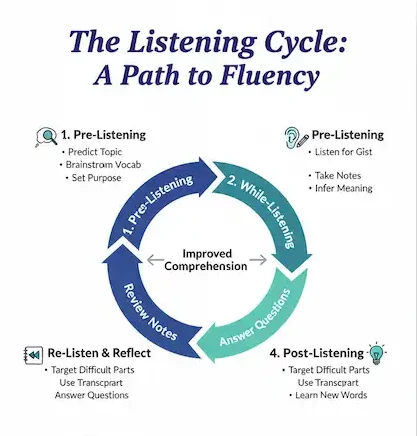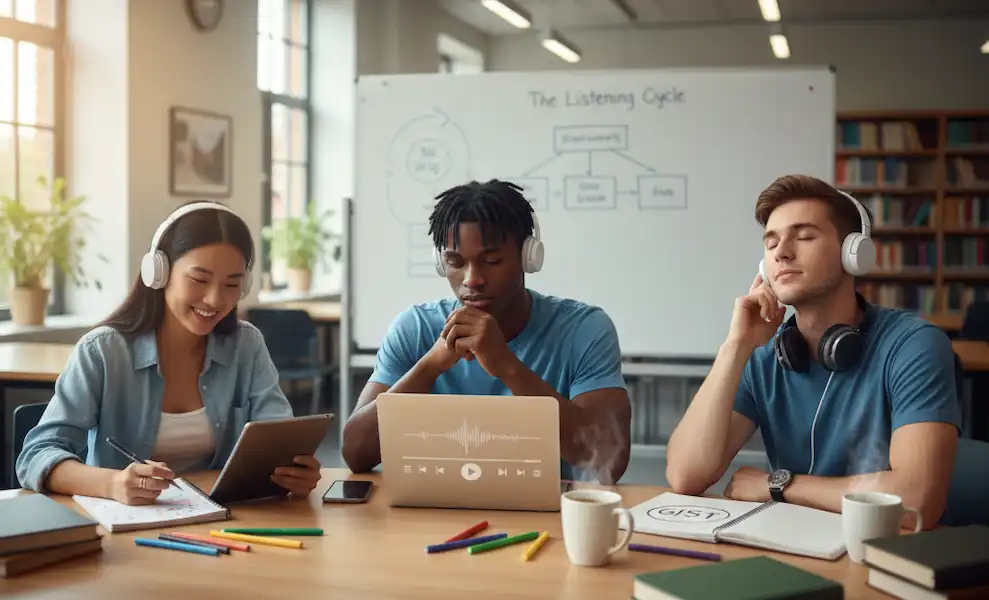Unlock Better Understanding: Supercharge Your English Listening Skills!
Are you an intermediate English learner who sometimes feels like you’re missing important details when native speakers talk? Do you wish you could follow conversations more easily or understand movies without constantly checking subtitles? You’re not alone! English listening skills and comprehension are skills that takes practice, and with the right strategies, you can make huge improvements. Humans have two ears and one mouth, we should listen twice as much as we speak.
This article will equip you with powerful techniques to enhance your listening skills, complete with practical examples, visual aids, and links to authoritative resources. Let’s dive in!
Why is Listening So Challenging (and So Important)?
Listening is often considered one of the most difficult language skills to master. Why?
- Speed: Native speakers often talk quickly.
- Pronunciation: Words can be linked together (connected speech), and some sounds are tricky.
- Vocabulary: You might not know every single word.
- Accents: Different accents can be hard to understand.
- Cultural Context: Sometimes, understanding requires knowing cultural nuances.
But here’s the good news: improving your English listening skills opens up a world of opportunities! You’ll enjoy movies, podcasts, and conversations more, feel more confident, and even improve your speaking skills.
Top Strategies for Improving Your English Listening Skills
Let’s explore some highly effective strategies:
1. Listening for Gist (or “Main Idea Listening”)
Imagine someone tells you a long story. You don’t need to remember every single detail to understand what happened generally. That’s “listening for gist”! It means understanding the main point or overall topic without getting stuck on every unknown word.
How to do it:
- Don’t panic about unknown words: Focus on the words you do know.
- Identify keywords: Listen for nouns, verbs, and adjectives that seem important.
- Ask yourself: “What is the speaker mainly talking about?” or “What’s the overall message?”
Example:
Listen to this short audio clip:
“Good morning, everyone. Today, we’re going to discuss the importance of healthy eating habits, especially for children. Many parents struggle to get their kids to eat vegetables, but there are some fun and creative ways to introduce them. We’ll look at a few recipes and tips later in the presentation.”
After listening, ask yourself: What was the main topic?
- A) Recipes for parents
- B) Eating vegetables
- C) Healthy eating habits for children
- D) Problems parents have
The best answer for the gist is C. While A, B, and D are mentioned, C encompasses the overall theme.
Activity: Listen to a short news report or a part of a podcast. After listening, write down one sentence summarizing the main idea. Don’t worry about details!
2. Inferencing (Reading Between the Lines)
Inferencing means understanding something that isn’t directly stated. You use clues from the conversation, your general knowledge, and context to guess the meaning. This is a crucial skill for understanding natural conversations where people don’t always say everything explicitly.
How to do it:
- Pay attention to tone of voice: Is the speaker excited, sad, angry?
- Notice body language (if watching): This provides visual clues.
- Use context: What was said before and after? What’s the situation?
- Draw on your general knowledge: What do you already know about the topic?
Example:
Listen to this dialogue:
Person A: “Oh no, it’s pouring outside! I completely forgot my umbrella.”
Person B: “Don’t worry, I have an extra one in my bag. You can use it.”
What can you infer?
- It’s raining heavily.
- Person A will get wet without an umbrella.
- Person B is offering to help Person A.
- They are probably outside or about to go outside.
None of these things were explicitly stated, but you can infer them from the conversation!
Activity: Watch a short scene from a TV show or movie without subtitles. Pause at different points and try to guess what the characters are feeling or what might happen next based on their expressions, tone, and the situation.
3. Note-Taking While Listening to Improve English Listening Skills
Note-taking isn’t just for lectures; it’s a powerful tool for active listening! It helps you focus, remember key information, and organize your thoughts. You don’t need to write down every word, just the most important points.
How to do it:
- Use abbreviations and symbols: (e.g., “+” for “and,” “w/” for “with,” “→” for “leads to”).
- Jot down keywords and phrases: Don’t write full sentences.
- Use bullet points or numbered lists: This helps organize information.
- Focus on main ideas and supporting details: What’s crucial to remember?
- Don’t try to write everything: If you miss something, keep listening. You can’t write and listen perfectly at the same time.
Example of simplified notes:
Imagine listening to a lecture on climate change:
- Topic: Climate Change – impacts
- Causes: Greenhouse gases ↑, factories, cars
- Effects: Temp ↑, ice melt, sea level ↑, extreme weather
- Solutions: Renewable energy, reduce waste, plant trees
Chart: Effective Note-Taking Techniques for English Listening Skills

| Technique | Description/Example |
| 1. Abbreviations | Use short forms |
| 2. Symbols | Visual cues |
| 3. Keywords/Phrases | Don’t write sentences |
| 4. Bullet Points | Organize info |
Activity: Find an English podcast or a short TED Talk (around 5-7 minutes). Listen once for the gist, then listen again and try to take notes using the techniques above. Compare your notes to a transcript if available afterward.
Additional Helpful Content for English Listening Skills Success
A. Pre-Listening Activities: Get Ready to Listen!
Before you even start listening, you can prepare your brain!
- Predict the topic: Look at the title or any images. What do you expect to hear?
- Brainstorm vocabulary: What words might come up related to the topic?
- Activate prior knowledge: What do you already know about this subject?
- Set a purpose: Are you listening for the main idea, specific details, or to understand an opinion?
Example: If you’re about to listen to a weather forecast, you can predict words like “rain,” “sun,” “cold,” “warm,” “temperature,” etc. You know the purpose is to find out what the weather will be like.
B. Post-Listening Activities: Check and Expand Your Understanding
What you do after listening is just as important!
- Review your notes: Can you understand them? Do they make sense?
- Summarize: Explain what you heard to yourself or a friend.
- Answer comprehension questions: Check if you understood specific details.
- Reflect: What was difficult? What words did you not know?
- Re-listen: Listen again to difficult parts, perhaps with a transcript this time.
Image: The Listening Cycle

C. Vary Your Listening Materials
Don’t stick to just one type of audio! Expose yourself to different:
- Accents: British, American, Australian, etc.
- Speech speeds: From slow, learner-focused audio to fast, natural speech.
- Topics: News, entertainment, academic, interviews, stories.
- Formats: Podcasts, songs, movies, TV shows, audiobooks, lectures.
The more variety, the better prepared you’ll be for real-life listening situations.
D. Practice, Practice, Practice!
Like any skill, listening improves with consistent practice. Aim for short, regular listening sessions rather than long, infrequent ones. Even 10-15 minutes a day can make a big difference!
Listen to this story and answer the questions.
Comprehension Questions:
- What did Mia love to do?
- What animal did Mia want to draw today?
- What color were the cat’s eyes?
- How did Mia feel about her drawing?
- Who did Mia decide to show her drawing to?
- What did Mia love to do? Draw
- What animal did Mia want to draw today? A Cat
- What color were the cat’s eyes? Green
- How did Mia feel about her drawing? She felt Proud
- Who did Mia decide to show her drawing to? Her Mom
Here is another story, listen to it and answer the questions.
Comprehension Questions:
- What did Leo usually look for on the sand?
- What two colors was the small wooden boat?
- How did the boat look to Leo (what quality)?
- Who did Leo show the boat to that afternoon?
- What name did Leo give to the boat?
- What did Leo usually look for on the sand? looking for shells
- What two colors was the small wooden boat? red and white
- How did the boat look to Leo (what quality)? it looked old
- Who did Leo show the boat to that afternoon? to his grandfather
- What name did Leo give to the boat? The Red Traveler
Additional Helpful Links
- Improve your reading skills – Beginner’s Guide: Reading Comprehension & Story Skills
Authoritative External Resources for Listening Practice:
- BBC Learning English: Offers a wide range of free resources, including news reports, dramas, and vocabulary lessons, specifically designed for English learners.
- TED Talks: Features inspiring talks on a vast array of topics, often with interactive transcripts available. You can filter by difficulty level.
- ESL-LAB: Provides free listening comprehension exercises for all levels, complete with quizzes and cultural notes.
- University of Cambridge English Language Assessment: Offers insights and official practice materials that can help understand what’s tested in exams and improve general skills.
- Voice of America Learning English: News and features presented in simpler English at a slower pace.
Conclusion
Improving your English listening comprehension is a journey, not a sprint. By actively using strategies like listening for gist, inferencing, and effective note-taking, combined with regular practice and varied materials, you will undoubtedly become a more confident and skilled listener. Remember to be patient with yourself, celebrate small victories, and keep pushing forward! Happy listening!




